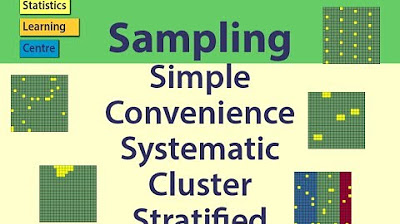Techniques for random sampling and avoiding bias | Study design | AP Statistics | Khan Academy
TLDRThe transcript discusses various sampling techniques for surveying student opinions on math instruction quality. It highlights the importance of random sampling, including simple random sampling, stratified sampling, and clustered sampling, to minimize bias and accurately represent the population. The transcript also warns against non-random sampling methods like voluntary surveys and convenience sampling, which can introduce bias. Additionally, it emphasizes the impact of survey wording and potential response bias on the integrity of the survey results.
Takeaways
- 📊 The goal of a survey is to gauge sentiments or opinions within a population, such as students' views on math instruction quality.
- 🏫 When dealing with a large population, conducting a census (surveying everyone) is often impractical, leading to the need for sampling.
- 🔁 A simple random sample involves assigning numbers to each member of the population and using a random number generator to select a subset for the survey.
- 🎯 While simple random sampling reduces bias, there's still a chance that the sample may not be fully representative due to random selection.
- 📂 Stratified sampling involves dividing the population into subgroups (strata) based on certain characteristics and then sampling from each subgroup to ensure representation.
- 👥 Clustered sampling involves sampling groups (clusters) of individuals that are expected to have a balanced demographic composition, surveying everyone within the selected clusters.
- ❌ Non-random sampling methods, such as voluntary surveys or convenience sampling, introduce higher risks of bias and may not accurately represent the population.
- 🖋 The wording of survey questions can introduce bias, influencing respondents' answers in positive or negative ways.
- 🤔 Response bias can occur when individuals are not truthful in their responses due to fear of repercussions or other concerns.
- 💡 Random sampling techniques help to minimize the introduction of bias, but it's important to be aware of potential pitfalls in survey design and execution.
Q & A
What is the main purpose of conducting a survey in a school setting according to the transcript?
-The main purpose of conducting a survey in a school setting, as per the transcript, is to understand how the students feel about the quality of math instruction provided at the school.
Why is it impractical to survey every single member in a large college with 10,000 students?
-It is impractical to survey every single member in a large college because of the sheer size of the population. Conducting a survey with such a large number of individuals would require significant resources, time, and effort, which may not be feasible or efficient.
What is the significance of having a random sample in a survey?
-A random sample is significant in a survey because it helps to avoid bias and provides the best chance of the results being indicative of the entire population. Random sampling ensures that every member of the population has an equal chance of being selected, leading to more representative and reliable outcomes.
What are the potential issues with a simple random sample?
-A simple random sample, while truly random, may by chance select a disproportionate number of certain groups (e.g., boys over girls, freshmen over seniors, engineering majors over English majors). This could potentially skew the results and not accurately represent the entire population.
How does stratified sampling help to address the potential issues of a simple random sample?
-Stratified sampling helps to address the potential issues of a simple random sample by dividing the population into subgroups (strata) based on certain characteristics (e.g., class year, major, gender) and then sampling from each subgroup. This ensures that each subgroup is adequately represented in the survey, leading to more accurate and comprehensive results.
What is a clustered sample and how does it work?
-A clustered sample is a method where the population is divided into groups (clusters) that are expected to have a good balance of the characteristics of interest (e.g., gender balance in classrooms). Instead of sampling individuals directly from the entire population, a certain number of clusters are randomly selected, and then every individual within those clusters is surveyed. This method ensures a representative sample while maintaining the balance within each cluster.
What are non-random sampling methods and why can they introduce bias?
-Non-random sampling methods, such as voluntary surveys or convenience sampling, involve selecting participants based on their willingness to participate or their availability rather than random selection. These methods can introduce bias because they may not represent the entire population; certain groups may be overrepresented or underrepresented based on their interest or availability to participate.
How can the wording of a survey question potentially introduce bias?
-The wording of a survey question can introduce bias by leading respondents to a particular answer or by evoking certain emotions or perceptions. Questions that are leading, emotionally charged, or framed in a particular way can influence how respondents answer, potentially skewing the results away from an accurate representation of their true feelings or opinions.
What is response bias and how might it affect survey results?
-Response bias refers to the tendency of respondents to provide answers that they believe are socially desirable or that they think the survey creator wants to hear, rather than their true opinions or behaviors. This can affect survey results by making them less accurate and reliable, as respondents may be overly positive, overly negative, or may choose not to respond at all due to fear of negative repercussions or privacy concerns.
What are some strategies to mitigate bias in survey sampling?
-Strategies to mitigate bias in survey sampling include using random sampling techniques such as simple random sampling, stratified sampling, and clustered sampling. Additionally, carefully crafting survey questions to avoid leading language and ensuring anonymity and confidentiality can help reduce response bias and increase the likelihood of obtaining honest and accurate responses.
Why is it important to have a representative sample in a survey?
-Having a representative sample in a survey is important because it ensures that the results accurately reflect the views and characteristics of the entire population. A representative sample allows for valid conclusions to be drawn and helps in making informed decisions based on the survey findings. Biases in the sample can lead to incorrect or misleading interpretations, which can have significant implications for decision-making and policy development.
Outlines
📊 Random Sampling Techniques for Surveys
This paragraph discusses the importance of random sampling in surveys to avoid bias and accurately represent a population. It introduces different random sampling methods, including simple random sampling, stratified sampling, and clustered sampling. Simple random sampling involves assigning numbers to individuals in a population and using a random number generator to select a sample. Stratified sampling divides the population into subgroups, or strata, and samples from each subgroup to ensure representation across different demographics. Clustered sampling involves selecting groups, or clusters, of individuals and surveying everyone within those groups. The paragraph also highlights the potential biases that can arise from non-random sampling methods, such as voluntary or convenience sampling, and the impact of survey wording and response bias on the results.
🚫 Potential Biases in Surveys
This paragraph delves into the various sources of bias that can affect the outcomes of surveys. It begins by discussing non-random sampling methods, such as voluntary surveys where respondents self-select to participate, potentially skewing the results. Convenience sampling is also mentioned, where the survey is administered to easily accessible individuals, which can introduce bias. The paragraph then touches on the influence of survey wording, which can subconsciously guide respondents' answers. Lastly, it addresses response bias, where individuals may not provide truthful answers due to fear of repercussions or other personal motivations. The importance of being aware of these biases and taking measures to mitigate them is emphasized for the integrity and reliability of survey data.
Mindmap
Keywords
💡population
💡survey
💡sampling
💡bias
💡random sample
💡stratified sample
💡clustered sample
💡non-random sample
💡response bias
💡wording of survey
Highlights
The concept of sampling a population to understand its views, such as the quality of math instruction in a school.
The challenge of conducting a truly random sample in a large population, like a college with 10,000 students.
The use of a simple random sample by assigning numbers and using a random number generator to select a subset of the population.
The potential for bias even in a simple random sample due to chance, such as a disproportionate selection of certain demographics.
Stratified sampling as a technique to ensure representation from different subgroups within the population, like different class years.
Clustered sampling as a method to sample groups that are expected to have a balanced demographic composition, like classrooms.
The risk of bias in non-random samples, such as voluntary surveys or convenience sampling, which may not accurately represent the entire population.
The impact of survey wording on the responses, which can introduce bias by guiding the respondent's answer in a certain direction.
Response bias, where participants may not answer truthfully or at all due to fear of repercussions or other concerns.
The importance of using random sampling to minimize the probability of introducing bias in the results.
The need to consider various sampling techniques to avoid pitfalls that can skew the outcomes of the survey.
The practical application of these sampling methods in a school setting to gauge student satisfaction with math instruction.
The theoretical contribution of understanding how different sampling methods can affect the integrity of survey data.
The innovative approach to handling large populations by employing stratified and clustered sampling techniques.
The potential ethical considerations when conducting surveys, such as ensuring anonymity and addressing response bias.
Transcripts
Browse More Related Video

Probability and Non-Probability Sampling in Research Methods

Sampling: Simple Random, Convenience, systematic, cluster, stratified - Statistics Help

Statistics Lecture 1.5: Sampling Techniques. How to Develop a Random Sample

Types of sampling methods with examples / sampling techniques (8)

Types of Sampling Methods (4.1)

Sampling Methods 101: Probability & Non-Probability Sampling Explained Simply
5.0 / 5 (0 votes)
Thanks for rating: